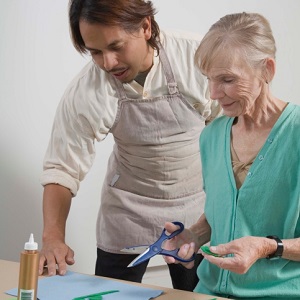Expressive Arts As Means to Heal Trauma

As a licensed clinical social worker, I often have drawn from the expressive arts as a means of helping my clients work through grief, loss, and trauma in psychotherapy. Art making, whether via collage, painting, drawing, sculpting, dancing, making music, and drama, has the potential to help individuals heal through very traumatic circumstances. The workshop focused on the evidence-based use of art making interventions and the intersection with neurobiology and somatic experiencing to help clients work through trying life challenges.
In my 20+ years of psychotherapy practice, I have called upon art intervention with the following populations: child witnesses of domestic violence, abuse survivors, hospice patients and their families, preschool children who witnessed L.A. riots, bereavement support groups, students struggling in academic settings, children of incarcerated parents, and mothers experiencing perinatal depression.
Art allowed clients to transcend their emotional pain, create a narrative through image of their trauma/loss, and subsequently “master” the trauma, thereby releasing the painful memory from its grip in the brain. Art continues to be transformative in my practice with clients and also in my own personal life.
As Malchiodi and Webb stated in their conference, we as humans all experience traumas across the lifespan. These incidents can be as “minor” as a traffic jam to as life-changing as the death of a family member. All traumas, no matter how seemingly big or small, are encoded in the brain’s amygdala where they are registered as potential alarm bells. The hippocampus then takes on the role of organizing these traumatic images, but struggles to encode them in such a way that makes sense to the cognitive (higher thinking/verbal) areas of the brain.Art making taps into the lower-level (somatic/limbic) areas of the brain and also allows the client to release trauma in a somatic (physically manifested/preverbal) manner. Some individuals are rendered speechless in moments of trauma. As researchers have indicated, Broca’s Area in the brain has the potential to shut down verbalization of trauma, as an individual is in a hyper-alert state of fight or flight.
Art making accesses the somatic elements of the brain, enabling a client to express emotion which at times cannot be verbalized initially. Art making creates containment, safety, encouragement, validation, and an opportunity to narrate the traumatic experience in such a way that the trauma is then organized in the brain so that the individual’s somatic experiencing of the trauma is reduced.
Relaxation exercises coupled with art making bring about great relief for many clients. Playing music that matches a resting heartbeat has been proven to induce a state of calmness in many trauma survivors. Some clients are compelled to also engage in other forms of expression, such as drum playing and dancing. Discharging the trauma physically (exercise, music making, etc.) and through the use of creativity in art allows the client to move through the experience with a sense of self-compassion, mastery of the trauma, and a restored sense of trust in one’s surroundings.
To summarize the workshop I attended in a small article would not lend justice to all the incredible learning experienced. Suffice it to say my education of expressive arts is ongoing, and continues to be a driving force in the work I am honored to provide along the people who come to see me for therapy. Truly, belief that the client has the power of self-determination and the awareness and knowledge within to interpret their own art making is essential in nonjudgmentally supporting the client.
Ongoing training in the cutting edge juxtaposition of art and science in expressive arts and neurobiology is incredibly exciting and groundbreaking. Mindfulness and positive psychology also weave their way into the expressive arts as a form of healing which empowers clients to transcend trauma and loss and evolve to a place of healing and wellness.
The following is a list of titles I have found to be inspiring and helpful for psychotherapists wishing to learn more on the path of incorporating expressive arts in their work with clients:
- Malchiodi, Cathy. (2002)The Soul’s Pallete: Drawing on Art’s Transformative Powers, Shambhala Publications
- Malchiodi, Cathy. (2006)The Art Therapy Sourcebook, McGraw-Hill
- Allen, Pat . (1995) Art is a Way of Knowing,Shambala Publications
- McNiff, Shaun (2004). Art Heals: How Creativity Cures the Soul, Shambhala Publications
- McNiff, Shaun (1992). Art as Medicine: Creating a Therapy of the Imagination, Shambhala Publications
The preceding article was solely written by the author named above. Any views and opinions expressed are not necessarily shared by GoodTherapy.org.